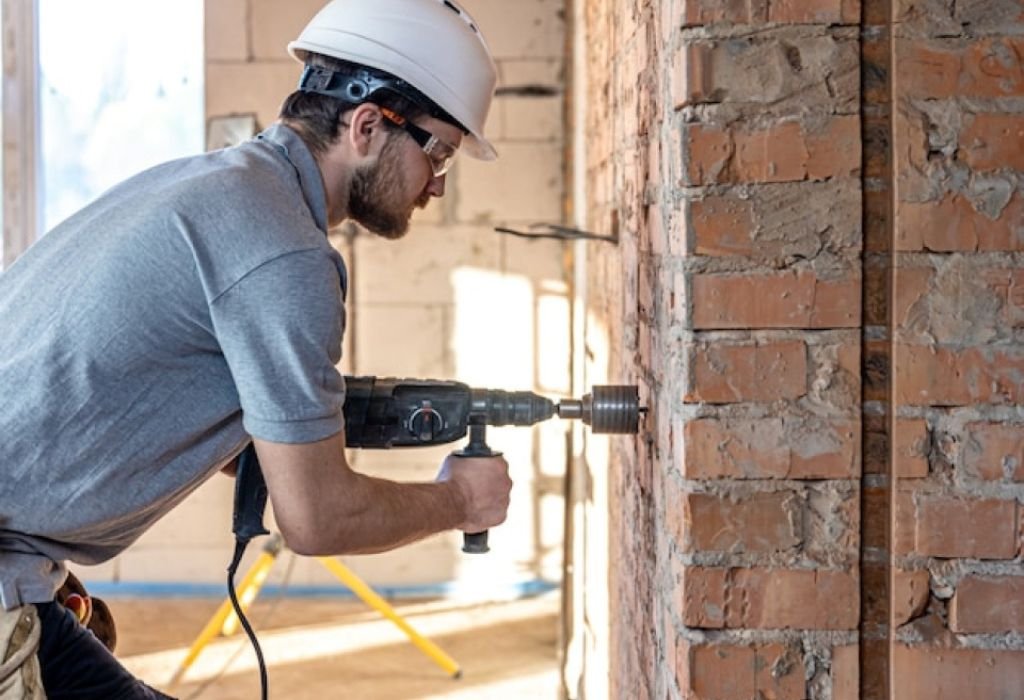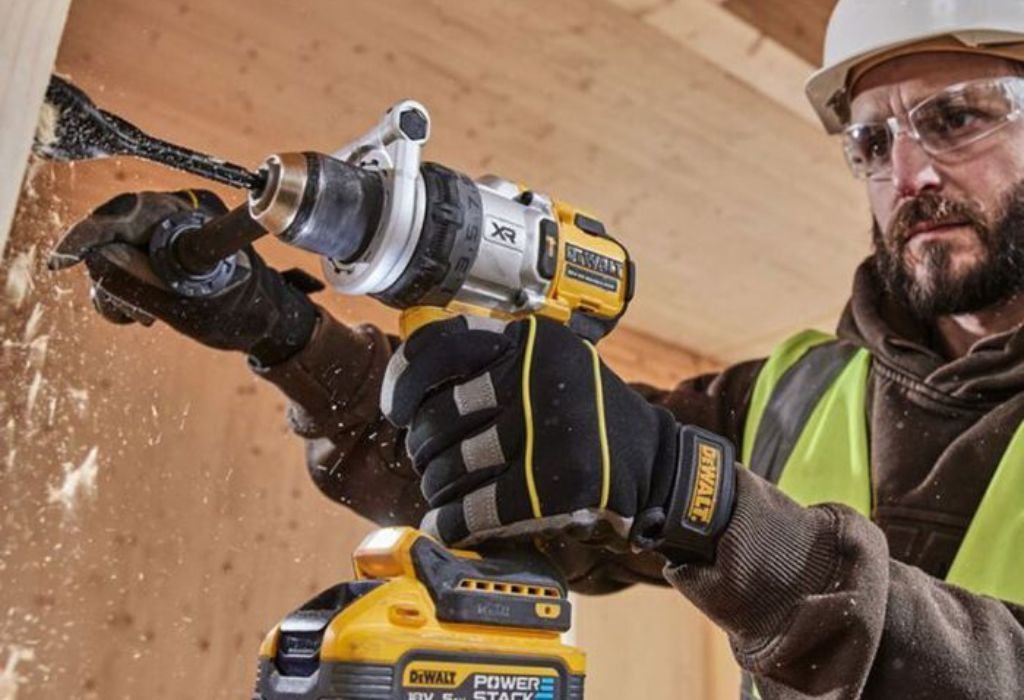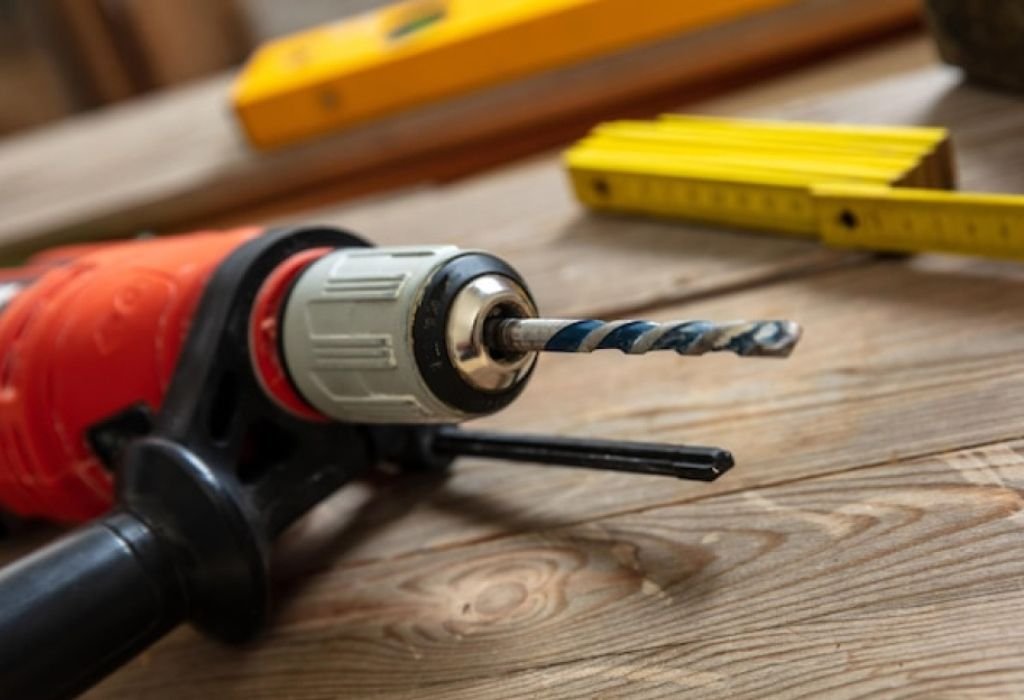Imagine working on a landscaping project where stubborn rocks block every step of progress.
A regular drill bit dulls quickly, a sledgehammer takes endless effort, and frustration builds as hours pass without results.
This is when many wonder if a rotary hammer can truly break rocks and save time.
Rotary hammers are built for more than just drilling holes in concrete. With their powerful piston-driven mechanism, these tools deliver impact energy far beyond what a standard drill can provide.
That extra force often raises the question: can it handle breaking rocks as well?
The curiosity is valid. Rocks vary in hardness, from softer limestone to dense granite.
Breaking them requires not only high impact power but also the correct chisels or pointed bits.
A rotary hammer, when paired with the right accessory, can turn into a rock-breaking solution for smaller to medium-sized jobs.
The importance of the right tool cannot be overstated. According to the global construction equipment market report, the demand for heavy-duty demolition tools is expected to grow by over 4% annually through 2030 (Statista).
This rise highlights the growing need for efficient tools like rotary hammers that can handle versatile tasks.
In this article, we’ll explore the truth behind the question: can a rotary hammer break rocks?
You’ll learn how it works, what limitations exist, the best practices for safety, and when it’s smarter to use alternative tools.
What Is a Rotary Hammer and How Does It Work?

A rotary hammer is a power tool designed for heavy-duty drilling and chiseling. Unlike a standard drill that relies on rotation and friction, a rotary hammer uses a pneumatic piston mechanism to deliver high-impact blows while rotating the bit. This mechanism is what gives it the ability to break tougher materials.
The tool was originally created for working with masonry and concrete. However, its unique design and the option to use different bits make it versatile enough to attempt breaking rocks. The constant hammering force transfers energy deep into the material, creating cracks that gradually lead to breakage.
Rotary hammers are typically rated by their impact energy, measured in joules. A model with higher joules delivers more powerful strikes, which is essential for tasks like breaking rocks or concrete slabs. The size and hardness of the rock often determine how effective the tool will be.
Modern rotary hammers often come with selectable modes, such as drilling only, hammer drilling, or chiseling. The chiseling function is what enables the tool to be used in rock-breaking applications, especially when fitted with pointed or flat chisels.
Can a rotary hammer replace larger demolition tools?
Not for major rock-breaking projects. It works best for smaller or medium-sized jobs.
Does a rotary hammer work like a jackhammer?
It uses a similar principle but at a smaller scale with less impact energy.
Is impact energy the most important factor?
Yes, higher joules make the tool more capable of breaking rock.
Can all rotary hammers break rocks?
No, only heavy-duty models with chiseling mode are suitable.
Types of Rocks and Their Breakability
Not all rocks are created equal. Some are relatively soft and easier to break, while others require immense force and specialized tools. Understanding the type of rock helps determine whether a rotary hammer can handle the job.
Soft rocks like limestone or sandstone tend to be more brittle. A rotary hammer with a chisel bit can break these down efficiently, making it a practical option for landscaping or small construction tasks.
Medium-hard rocks such as marble or shale present more of a challenge. While a rotary hammer can chip away at them, progress will be slower, and the tool may require frequent pauses to avoid overheating.
Hard rocks like granite and basalt are the toughest to break. These materials often demand a jackhammer, rock splitter, or blasting for efficient results. A rotary hammer may chip the surface but will struggle to achieve significant breakage.
Does rock hardness affect tool performance?
Yes, harder rocks require more impact energy than a rotary hammer usually provides.
Can limestone be broken with a rotary hammer?
Yes, it is soft enough for chiseling with the right bit.
Is granite too hard for rotary hammers?
Generally yes, most consumer-grade rotary hammers cannot handle granite.
Do all rock types react the same way to impact?
No, rock composition and density greatly affect breakability.
Choosing the Right Rotary Hammer for Rock Breaking
The effectiveness of rock breaking depends heavily on the type of rotary hammer being used. Entry-level models designed for light-duty drilling will not perform well in rock-breaking scenarios. Heavy-duty professional models stand a much better chance.
When selecting a rotary hammer, impact energy is a critical factor. Models with ratings above 5 joules are generally more capable of handling chiseling tasks. Corded models often provide consistent power, while cordless models add flexibility but may drain batteries quickly under heavy loads.
Another factor is the bit system. Most rotary hammers use SDS-Plus or SDS-Max shanks. SDS-Max hammers are larger, heavier, and designed for demolition, making them better suited for breaking rocks. The larger bits transfer more energy into the rock with each strike.
Weight also plays a role. Heavier rotary hammers, often 12 lbs or more, provide more force with each blow, reducing the effort required by the operator. These are preferred when attempting to chip or break rock.
Which rotary hammer type works best on rocks?
SDS-Max models are better suited than SDS-Plus for rock breaking.
Are cordless rotary hammers effective for rocks?
Yes, but battery life limits prolonged use under heavy loads.
Does tool weight matter?
Yes, heavier tools often deliver stronger impacts.
Should a beginner use a light or heavy-duty hammer?
A heavy-duty model is better for rocks, though beginners should learn safety first.
Best Drill Bits and Chisels for Rock Breaking

The tool alone is not enough. The choice of bit or chisel determines how efficiently rocks can be broken. Rotary hammers are compatible with a range of accessories designed for specific purposes.
For rock breaking, pointed chisels are the most effective. These concentrate the impact energy onto a small surface area, causing cracks to spread through the rock. Flat chisels are also useful for splitting and shaping softer stones.
In some cases, wide chisels can be used to remove larger sections of material quickly. However, for denser rocks, a narrower chisel is usually more effective. Using the wrong bit can waste time and reduce tool lifespan.
High-quality carbide-tipped bits are also essential. Inferior bits may dull quickly, overheat, or even shatter under stress. Professional-grade bits ensure consistent performance and safer operation.
What is the best chisel for breaking rocks?
A pointed chisel is most effective for creating cracks in rocks.
Can flat chisels break rocks?
Yes, but they are better suited for splitting or shaping softer stones.
Do carbide-tipped bits last longer?
Yes, they resist wear and heat better than standard steel bits.
Is it safe to use regular drill bits for rocks?
No, they will dull quickly and may cause tool damage.
Safety Precautions When Using a Rotary Hammer on Rocks
Rock breaking is not only tough on tools but also potentially dangerous for operators. Safety should always be a top priority before attempting any project.
Flying rock fragments pose a serious risk. Operators must wear safety goggles or a face shield to protect against debris. Hearing protection is also important, as rotary hammers produce significant noise levels.
The tool generates strong vibrations, which can cause fatigue or even hand-arm vibration syndrome if used for long periods. Wearing padded gloves and taking frequent breaks helps reduce strain.
Dust is another concern, especially when working with silica-rich rocks. Using a dust extraction system or wearing a proper respirator ensures safer working conditions.
Do I need eye protection when breaking rocks?
Yes, safety goggles or a face shield are essential.
Should I use hearing protection?
Yes, rotary hammers are loud and can cause hearing damage over time.
Is dust dangerous?
Yes, rock dust can be harmful and requires masks or respirators.
How can I reduce vibration impact?
Use padded gloves and take breaks regularly.
Limitations of Rotary Hammers in Rock Breaking
While rotary hammers can be effective in certain situations, they are not a one-size-fits-all solution. Understanding their limitations prevents frustration and tool damage.
Rotary hammers are best suited for smaller rocks or controlled chiseling tasks. Large boulders or dense materials like granite often exceed their capabilities. In such cases, larger demolition hammers or jackhammers are more efficient.
Overheating is another issue. Prolonged use at maximum power can cause the motor to overheat or reduce tool lifespan. Alternating between work and rest periods is recommended.
Finally, efficiency drops drastically when working with rocks that are deeply embedded in the ground. The tool may chip away at the surface but will struggle to achieve significant results without additional help.
Can rotary hammers break large boulders?
No, they are better for small to medium-sized rocks.
Will the tool overheat during long use?
Yes, frequent breaks are needed to prevent overheating.
Are embedded rocks harder to break?
Yes, rocks fixed in the ground require more powerful tools.
Is a rotary hammer a substitute for a jackhammer?
No, it is a smaller-scale tool with limited breaking capacity.
Alternatives to Rotary Hammers for Rock Breaking

When rocks are too large or too dense, other tools provide more effective solutions. Choosing the right tool saves time and reduces wear on equipment.
Jackhammers are the most obvious alternative. These deliver significantly higher impact energy and are designed for breaking large concrete slabs and dense rocks. They are heavy and less portable but excel in raw power.
Hydraulic rock splitters are another option. Instead of hammering, they insert a wedge into drilled holes and apply hydraulic pressure, splitting the rock from within. This method is precise and effective for larger rocks.
Angle grinders with diamond blades can be used to score and weaken rocks before breaking them apart with a hammer or chisel. This method is slower but provides control for detailed work.
Explosives or chemical rock breakers are sometimes used in mining or large-scale demolition projects. These require professional handling and are not suitable for casual use.
What tool is best for large rocks?
Jackhammers or hydraulic splitters are better than rotary hammers.
Can chemicals break rocks?
Yes, but they are specialized and require expert handling.
Is an angle grinder effective for rock breaking?
It can help weaken rocks before chiseling but is slower.
Are rotary hammers cost-effective for rocks?
Yes, for smaller tasks they are cheaper and easier to use.
Conclusion
Rotary hammers are versatile and powerful tools, but their rock-breaking ability depends on the situation. With the right model, chisel, and technique, they can handle softer and medium-hard rocks effectively. However, for larger boulders or extremely hard materials, specialized tools like jackhammers are the smarter choice.
Safety and tool longevity must also be considered. Protective gear, proper bits, and regular breaks help ensure efficient and safe operation. Knowing when to use a rotary hammer and when to choose alternatives prevents wasted effort and frustration.
In the end, the answer to “Can a rotary hammer break rocks?” is yes — but with limitations. For the right jobs, it’s a valuable solution. For others, heavier equipment may be the only way forward.

I’m John F. Nicholas, the founder, lead writer, and drill enthusiast behind 101drill.com. With years of hands-on experience in power tools and DIY projects, I created this platform to share practical knowledge, expert tips, and real-world insights to help others master the art of drilling.
